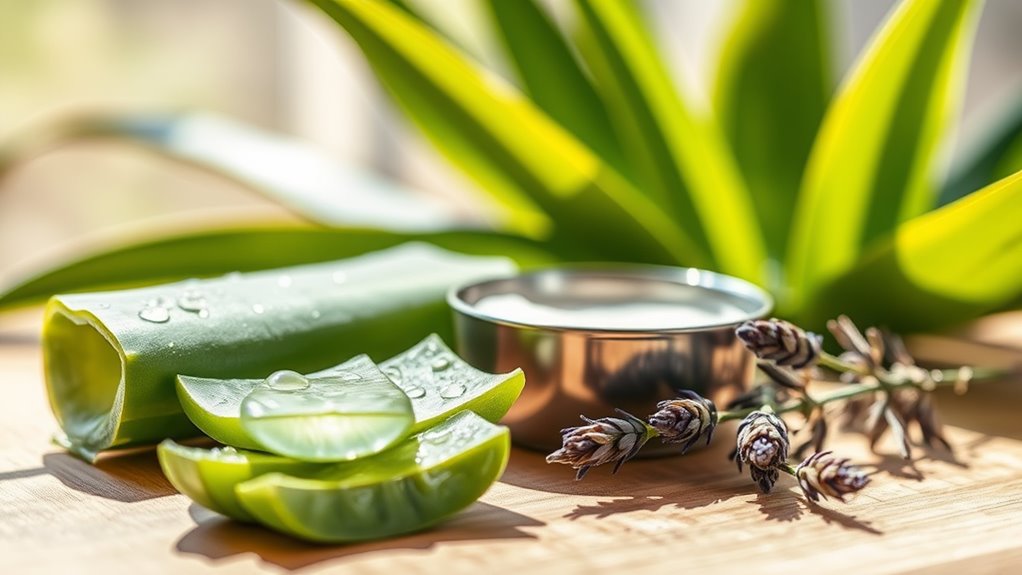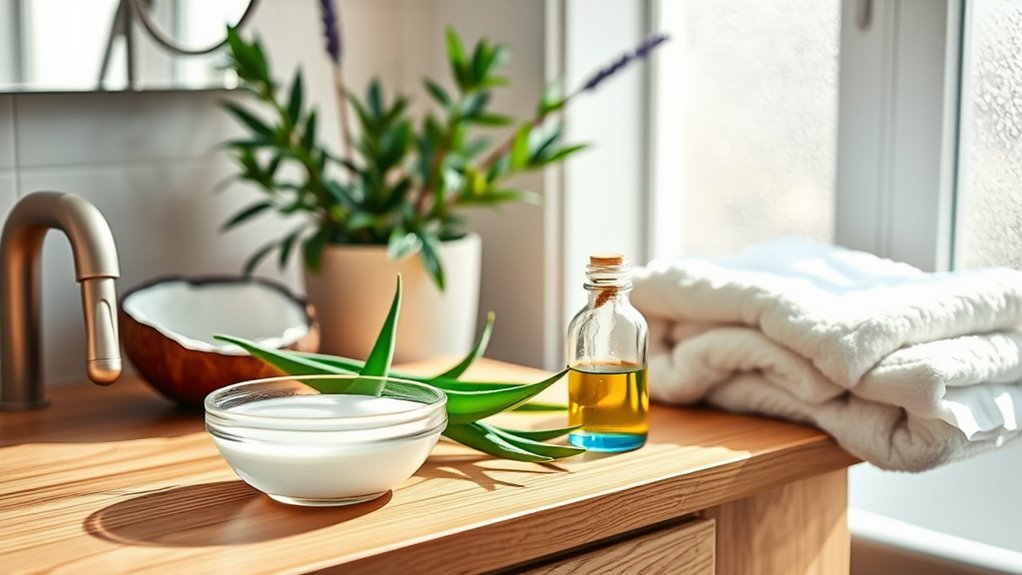How to Soothe Your Skin After a Sunburn the Natural Way
After a sunburn, your skin requires immediate attention to relieve discomfort and promote healing. Natural remedies can be effective in soothing your skin and reducing inflammation. From the cooling properties of aloe vera to the moisturizing benefits of coconut oil, various options exist to help alleviate pain. Understanding these methods and their utility can greatly impact your recovery process. Let’s explore how you can effectively care for your skin and enhance your healing journey.
Key Takeaways
- Apply fresh aloe vera gel multiple times a day to reduce redness, swelling, and promote healing with its cooling properties.
- Use cool compresses on the affected area for 15-20 minutes to alleviate discomfort and inflammation.
- Incorporate moisturizing treatments like colloidal oatmeal to create a protective barrier and reduce itchiness.
- Stay hydrated by drinking plenty of water and consuming fruits and vegetables to support skin recovery.
- Avoid direct sunlight and wear loose clothing to prevent further irritation while your skin heals.
Aloe Vera Gel: Nature’s Healing Agent
Aloe vera gel is often hailed as nature’s healing agent for sunburned skin.
This succulent plant contains compounds like aloin and acemannan, which boast anti-inflammatory properties that can greatly reduce redness and swelling.
When you apply aloe vera gel, it hydrates your skin, promoting healing while providing a cooling sensation.
It’s one of the most effective sunburn remedies available, as it not only alleviates discomfort but also helps prevent peeling.
To maximize its benefits, use pure aloe vera gel, preferably fresh from the plant.
Incorporating this natural remedy into your post-sun care routine can make a noticeable difference in your recovery. Additionally, applying aloe vera gel multiple times a day can enhance the healing process and provide sustained relief.
Coconut Oil: Moisturizer and Anti-Inflammatory
Coconut oil serves as both a moisturizer and an anti-inflammatory agent, making it an excellent choice for soothing sunburned skin.
Its high-fat content provides deep hydration, helping to restore moisture lost due to sun exposure. Additionally, coconut oil contains lauric acid, which has anti-inflammatory properties that can reduce redness and swelling.
When applied to sunburned areas, it forms a protective barrier, preventing further moisture loss. This natural oil absorbs easily, promoting skin repair without clogging pores. For best results, gently massage the oil onto affected areas, allowing your skin to reap the benefits of its soothing and nourishing qualities. Furthermore, using coconut oil along with antioxidants that combat free radicals can enhance its healing properties and support skin recovery.
Oatmeal Baths: Soothing Relief for Irritated Skin
Oatmeal baths provide a simple yet effective remedy for soothing irritated skin after sunburn.
Colloidal oatmeal, finely ground oats, contains anti-inflammatory properties that help reduce redness and itchiness.
When you soak in an oatmeal bath, the proteins and lipids in the oats create a protective barrier on your skin, locking in moisture and promoting healing.
To prepare, mix finely ground oats into warm water and stir until it’s milky.
Soak for about 15-20 minutes, allowing your skin to absorb the soothing properties.
Rinse off gently afterward, and pat your skin dry to maintain the hydration benefits. Additionally, adding beta-glucans in oats can further help retain moisture, enhancing the healing process.
Cold Compresses: Immediate Cooling Effect
Cold compresses offer immediate relief for sunburned skin by reducing inflammation and providing a soothing effect.
To maximize their benefits, you’ll want to apply them correctly and choose the right materials.
Understanding these techniques can help you effectively cool your skin and promote healing. Additionally, remember that cool compresses can significantly lower skin temperature and alleviate discomfort when used consistently throughout the day.
Benefits of Cold Compress
A cold compress serves as an effective remedy for alleviating the discomfort of sunburned skin.
The immediate cooling effect not only soothes but also reduces inflammation.
Here are three key benefits of using a cold compress:
- Pain Relief: It numbs the area, providing instant comfort from the burning sensation.
- Reduced Redness: The cold constricts blood vessels, minimizing redness and irritation.
- Hydration: When infused with soothing ingredients like aloe vera, it helps replenish moisture, promoting healing.
Application Techniques Explained
Using a cold compress effectively requires specific techniques to maximize its soothing benefits for sunburned skin.
First, choose a clean cloth or towel and soak it in cold water or wrap ice in a thin layer of fabric. Avoid direct ice contact to prevent further skin damage.
Apply the compress gently, ensuring it covers the affected areas without excessive pressure.
Leave it on for 15-20 minutes, allowing your skin to absorb the cooling effect.
Repeat this process every few hours as needed.
Always dry your skin gently afterward to maintain moisture, promoting healing while avoiding irritation.
Chamomile Tea: Anti-Inflammatory Properties
Chamomile tea offers significant anti-inflammatory benefits that can help soothe your sunburned skin. By preparing a chamomile infusion and applying it correctly, you can harness its healing properties for effective relief. Additionally, the mild sedative effects of chamomile can promote relaxation, enhancing your overall comfort during the healing process. Understanding these techniques will enhance your post-sunburn care routine.
Chamomile’s Healing Benefits
The soothing properties of chamomile tea make it a powerful ally in alleviating the discomfort of sunburned skin.
Its anti-inflammatory effects can help reduce redness and swelling, providing much-needed relief.
Here are three key benefits you’ll experience:
- Calming effect: Chamomile’s natural compounds help relax irritated skin, promoting a sense of comfort.
- Moisturizing properties: It hydrates the skin, preventing further dryness and peeling.
- Antioxidant protection: Chamomile contains antioxidants that combat free radicals, aiding in the healing process.
Incorporating chamomile tea into your sunburn care routine can greatly enhance your skin’s recovery.
Preparing Chamomile Infusion
To harness the anti-inflammatory properties of chamomile, preparing an infusion is straightforward and effective.
Start by boiling water in a pot. Once it reaches a rolling boil, remove it from heat and add two to three teaspoons of dried chamomile flowers.
Allow the mixture to steep for about 10 minutes. This steeping time extracts beneficial compounds, enhancing its soothing effects.
After steeping, strain the infusion to remove the flowers. You can refrigerate the infusion for later use.
This chamomile infusion can provide relief and promote healing, making it a valuable addition to your post-sunburn care routine.
Application Techniques for Relief
How can you effectively apply chamomile tea for relief from sunburn?
Start by cooling your chamomile infusion to room temperature.
Then, follow these steps for maximum relief:
- Cotton Pad Application: Soak a clean cotton pad in the tea and gently press it onto the sunburned areas.
This helps deliver soothing properties directly to your skin.
-
Compress Method: Dampen a soft cloth with the infusion and lay it over the affected areas for 10-15 minutes, allowing the chamomile to work its magic.
-
Spray Bottle: Fill a spray bottle with cooled tea and mist it over your skin for a cooling, instant relief.
Hydration: The Importance of Water for Recovery
Why is hydration essential for your skin’s recovery after a sunburn?
Water plays an essential role in your skin’s healing process. After sun exposure, your skin loses moisture, leading to dryness and increased irritation.
Staying hydrated helps replenish this lost moisture, promoting faster recovery and reducing peeling.
Additionally, water supports cellular functions, aiding in the repair of damaged skin tissues. It also helps detoxify your body, flushing out toxins that can exacerbate inflammation. Moreover, staying hydrated can enhance the effectiveness of topical treatments you may apply.
To optimize recovery, drink plenty of water and consider hydrating foods like fruits and vegetables. Prioritize hydration to soothe your skin effectively and accelerate healing.




